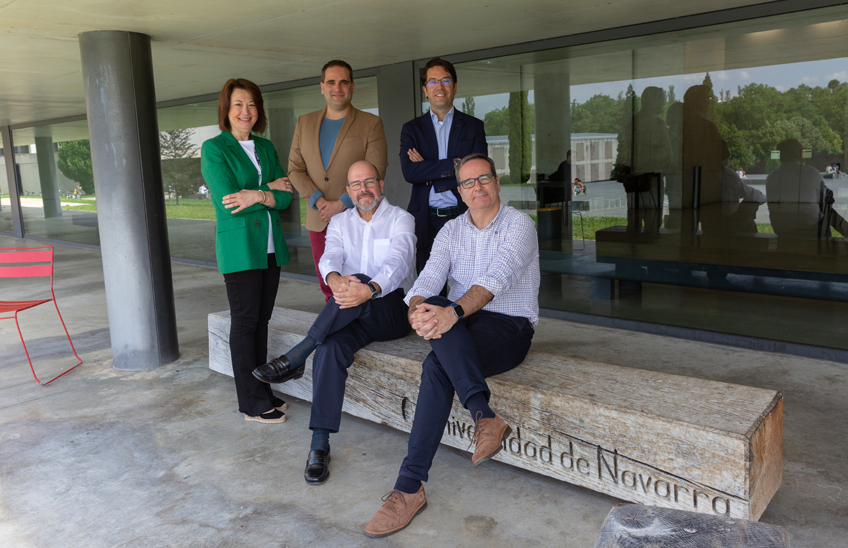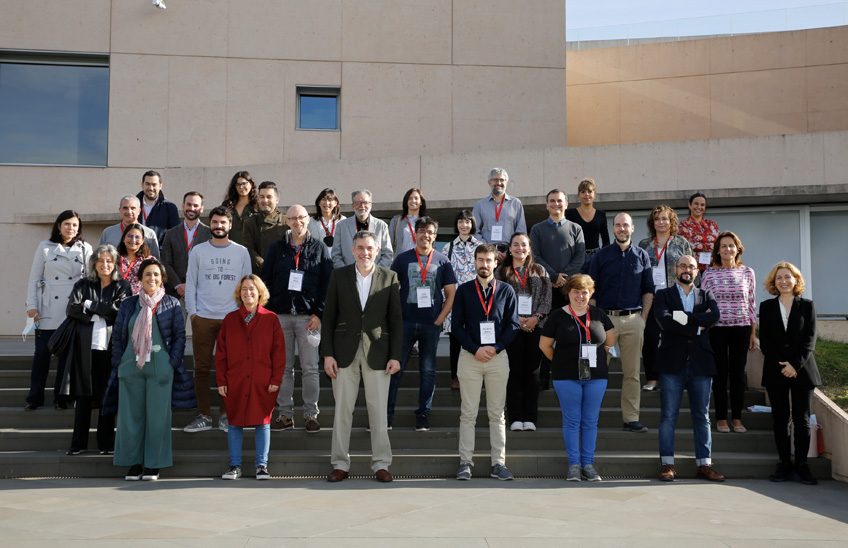Journalistic brands are adapting to a new market where the challenge of trust coexists with the popularity of new channels, formats and referents.
33% of Spaniards usually trust the news, 52% show a high interest in current affairs and 37% are neither interested in the news nor usually trust them.

FotoManuelCastells/University of Navarra researchers who have elaborated the report. From left to right, in the second row, Elsa Moreno, Samuel Negredo and Jürg Kaufmann. In the front row, Avelino Amoedo and Alfonso Vara.
14 | 06 | 2023
Faced with an information market characterized in Spain by a waning interest in news, a loss of confidence and a broad negative social perception of journalism (57% of Spaniards regularly hear negative criticism of the profession), Spanish audiences have reacted in many ways. Journalistic brands have adapted to this new market in which new channels, formats and news referents have gained popularity.
First, the growing issue of Spaniards who do not use any information source (this group has gone from 1% in 2016 to 7% in 2023) or often avoid news (29%) is of concern. Among those who continue to inform themselves, news consumption has reduced or stagnated, both in traditional and digital supports. Television resists this year the push of social networks and is still the most used (56%) and favorite medium for information (37%). The total preference for non-digital traditional media (53%) coexists with the regular use of online media (47%).
Spaniards who avoid news mainly dispense with "hard news". In Spain, national politics (39%), the war in Ukraine (34%) and business, finance and Economics (27%) are the most avoided topics. Local information, on the other hand, is only avoided by 7%. The closest current affairs remain as a social value of sustained interest.
These are some of the conclusions of the report Digital News Report Spain 2023, prepared by researchers from the School of Communication of the University of Navarra, based on a survey conducted by YouGov at partnership with the high school Reuters of the University of Oxford.
Alternative channels and formats coexist with journalistic brands
The report also highlights the growing popularity of other forms of information, such as podcasts and social networks, especially among the new generations. Spain leads Europe in podcast consumption (45%) and 39% of the population uses social networks for information purposes. Facebook (30%) and Twitter (18%) continue to lead the informative use of these networks and TikTok is already employee to read, watch, find, share or comment on news by 10% of respondents.
There is also a decline in the issue of journalistic brands used to inform themselves: only 55% of respondents turn to five or more media outlets in 2023, down from 81% in 2016. This suggests a consolidation of reference letter brands and a preference for more specialized or trusted news sources.
The report points to the permanence of traditional newspaper brands and the more established digital native media, which continue to lead in both usage and preferences of the majority of audiences. The credibility of most of the brands analyzed increases considerably in 2023, and overall the percentage of respondents who regularly trust them is higher than group who do not trust them.
Within this group of journalistic brands, the strength of regional and local media stands out as the most credible of all the brands analyzed and the most immune to information fatigue. This data contrasts with the figures of the public media: 45% of the Spaniards consider that the public media are relevant for society, thirteen points below the average of the nineteen countries where this issue was analyzed. However, RTVE is among the most trusted brands of the 14 analyzed in the study: 48% of those surveyed trust its news, as opposed to 26% who do not.
Slow but steady increase in digital news payments
Within the audiences that continue to bet on reference letter brands and quality journalism, the percentage of Spaniards paying for digital news is growing: 13.3% of respondents paid for digital information in 2023, the highest figure since this study began in 2014. More importantly, more than half of those who pay subscribe to two or more media (52%), placing Spain among the countries with the highest average number of subscriptions per subscriber.
In contrast, these data reflect that the majority of Spaniards are not willing to pay, but suggest that there is a small percentage who do, motivated by reading or following specific journalists, quality information and commercial promotions/offers. Moreover, even printed information seems to resist for the third consecutive year: 25% of unyielding respondents declared having bought printed information products (newspapers or magazines) in the week prior to survey.
Economic information in Spain
Finally, report devotes a special chapter to how Spaniards inform themselves about economic and financial matters. In a scenario in which 80% of those surveyed say they are very affected by the increase in the cost of living, the majority are informed about economic matters by generalist media (39%), go to relatives, friends or colleagues at work (32%), turn to experts with an independent public profile (26%) or to media specializing in Economics, finance and business (17%). Unfortunately, the majority of respondents do not understand economic news (40%) and find it difficult to apply it to their ordinary life (38%), and 18% never pay attention to it.
The survey Digital News Report and the report Digital News Report Spain
The authors of the report Digital News Report Spain 2023 and responsible for the interpretation of these data are researchers at School of Communication of the University of Navarra, sponsor and partner academic since the 2014 edition. Digital News Report is a project of high school Reuters for the Study of Journalism at the University of Oxford, based on a survey conducted by YouGov covering 46 markets.
The survey is based on an online panel from which a sample of more than two thousand people (N = 2031 in this edition) is taken, representative of the adult population connected to the Internet, based on various demographic, socioeconomic and territorial factors. The work fieldwork in Spain was carried out between January 10 and February 14, 2023.
The report Digital News Report Spain 2023, with dozens of graphics, is available in open access for enquiry and attribution.
The study is part of the results of the project IBERIFIER, co-financed by the European Union, in the call CEF-TC-2020-2 (European Digital average Observatory), under the agreement issue INEA/CEF/ICT/A202072381931, Action 2020-EU-IA-0252. This project is part of the area Society and Digital Communication of the 2025 Strategy of the University of Navarra.
In addition, the report is also part of the project of research and development+i Medios nativos digitales en España: tipologías, audiencias, construcción de la confianza y claves para la sostenibilidad periodística - DIGINATIVEMEDIA - reference letter PID2021-122534OB-C22, funded by the Ministerio de Ciencia e Innovación/Agencia Estatal de research /10.13039/501100011033/ and the European Regional Fund development "Una manera de hacer Europa".




